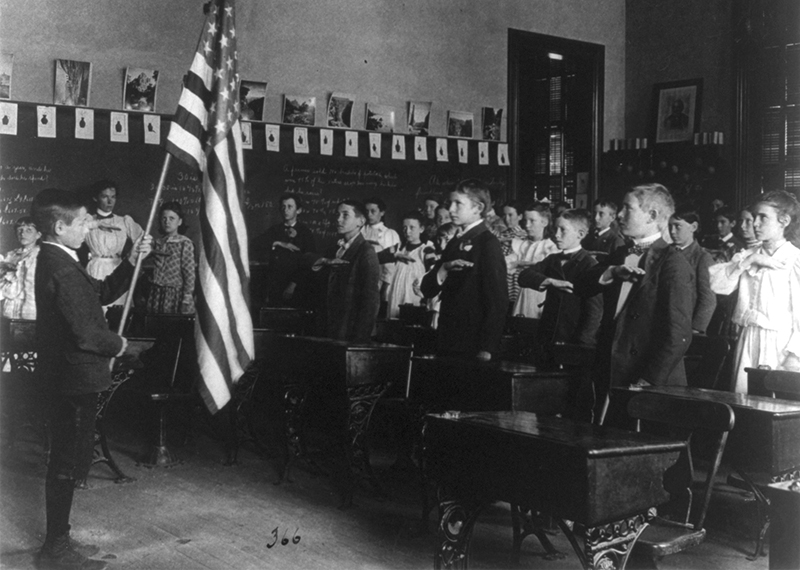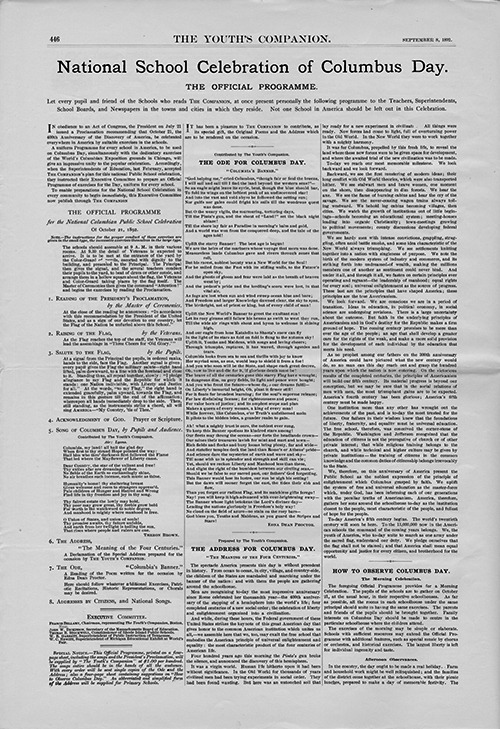THE PLEDGE OF ALLEGIANCE
On June 22, 1942, Congress adopted the Pledge of Allegiance as the official oath of the United States. In addition, the law also created the official Flag Code, including regulations for display, care, and etiquette of the American flag. The only change made to the Pledge after it was signed into law was on June 14, 1954, when two words were added, rendering it in its current state today.
I pledge allegiance to the flag of the United States of America, and to the Republic for which it stands, one Nation under God, indivisible, with liberty and justice for all.
This iconic piece of American history and culture was not written by a politician, a military officer, an educator, or a poet. It was actually written by a marketer who was trying to sell flags to public schools.

The two men responsible for the Pledge of Allegiance are James Upham and Francis Bellamy. Both worked for the children's magazine The Youth's Companion in Boston, Massachusetts, where they were responsible for promotions and increasing subscriptions. In 1888, James Upham conceived the idea to sell American flags to public schools. At the time, only government and military institutions displayed the flag. Upham believed that if he could convince schools to purchase flags, he could not only increase profits by a huge margin, but he could also vastly increase exposure for The Youth's Companion, thereby creating more subscriptions. Upham sought endorsements from the National Education Association and the federal government, but despite his efforts, public schools just didn't see the value in purchasing flags.
In 1891, the magazine hired Francis Bellamy to assist with promotions. The following year would mark the 400th anniversary of Christopher Columbus's historic voyage to America, and a giant exposition was already scheduled to be held in Chicago. Upham believed the moment was perfect for their scheme, and put Bellamy in charge of somehow linking the magazine and its flag campaign with the Columbus Exposition. Bellamy spent months contacting everyone from school superintendents to the President of the United States. His efforts secured a special flag-raising ceremony at the exposition sponsored by The Youth's Companion, and President Benjamin Harrison declaring October 12, 1892 to be a national holiday, Columbus Day.
To add gravitas to the ceremony where a group of children would salute the flag as it was hoisted, Bellamy composed a short pledge that could be recited in unison. The pledge was published in the September 8, 1892 issue of the magazine. The combination of a new national holiday coinciding with a huge exposition and a reverent ceremony that was simple for children to exercise paid off. Within one year, the company sold flags to 25,000 schools, and over 13 million students had recited the new pledge. By the time the pledge became part of U.S. law, most schools had already adopted it as part of their days.

Today only three states do not have official laws requiring a moment for the Pledge of Allegiance. It is used to begin every session of Congress and most state and local government meetings. Nearly one million new citizens recite the pledge every year during their naturalization ceremonies. And American flags are now a $100 million commodity, with 150 million sold each year in every size imaginable. The 31 words of the Pledge of Allegiance are arguably the most well-known statement of America known by Americans, more than the national anthem, the Declaration of Independence, and the Constitution. Sometimes an idea, even a marketing idea, can become bigger than its intent.
SOURCES
- "Title 4, Chapter 1, Section 4" from the United States Code
- September 8, 1892 issue of The Youth's Companion from the Saturday Evening Post
- "A Brief Synopsis of the Story of the Origin of the Pledge Taken from the Detailed Narrative by Francis Bellamy" from the Congressional Record of the 83rd Congress 1954
- "The Pledge of Allegiance’s Creepy Past" from JSTOR
- "Pledge of Allegiance created to sell flags" from the Gilroy Dispatch
- "How the Pledge of Allegiance Went From PR Gimmick to Patriotic Vow" from Smithsonian Magazine
- "American Flags, Born in the U.S.A." from the Richmond Times-Dispatch













